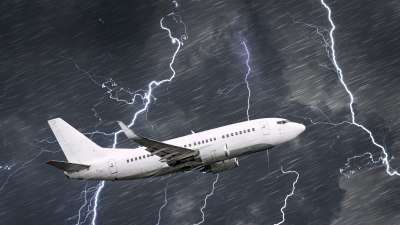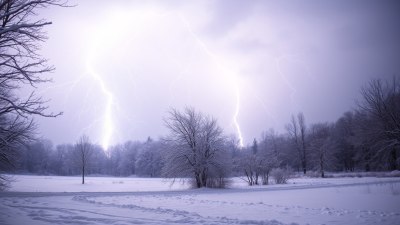How Lightning Strikes an Airplane
Learn about the fascinating science behind lightning strikes on airplanes and their safety features.

Lightning strikes are a common phenomenon that can pose a significant risk to various forms of transportation, including commercial airplanes. Although the thought of an aircraft being struck by lightning may seem alarming, the truth is that planes are engineered to handle such situations effectively. In this article, we will explore how lightning interacts with airplanes, the science behind it, and what measures are taken to ensure passenger safety.
Understanding Lightning Formation
Before delving into the specifics of lightning strikes on airplanes, it is essential to understand how lightning is formed. Lightning is a massive electrostatic discharge resulting from the buildup of electrical charges in clouds. Thunderstorms are the primary source of this buildup, as they contain both positive and negative charges. When the difference between these charges becomes significant enough, a discharge occurs, resulting in a lightning strike.
Airplanes and Lightning Strikes
Airplanes are struck by lightning more often than one might think; in fact, an average commercial aircraft is hit by lightning approximately once a year. Despite this frequency, airplanes are designed with incredible resilience to withstand such strikes. The fuselage of an airplane acts as a Faraday cage, allowing the electrical current to travel around the outside of the aircraft without penetrating the interior.
Safety Features on Commercial Airplanes
To manage the risks associated with lightning strikes, airplanes are equipped with several safety features. These include enhanced materials and designs that mitigate the effects of a strike. For instance, metallic elements in the aircraft's structure allow the electric charge to distribute evenly across the surface, preventing too much stress on any single point.
How Lightning Contacts an Airplane
When an airplane is struck by lightning, the electric charge typically contacts the aircraft at the leading edge of the wing or the nose, both of which are designed to absorb the impact. The lightning discharge travels along the exterior of the airplane and exits typically at the tail or the wingtips, reducing potential damage to the aircraft's vital systems.
Impact on Aircraft Electronics
One of the most significant concerns during a lightning strike is the potential impact on an aircraft's electronic systems. However, modern airplanes are equipped with numerous redundancies to safeguard against this. Critical systems and components are shielded, and grounding paths are provided to direct the surge safely away from sensitive systems.
Historical Instances of Lightning Strikes
Despite the protective engineering in place, there have been instances where lightning strikes have caused issues for airplanes. In rare cases, an aircraft's systems may encounter temporary malfunctions, such as sparking or smoke. However, pilots are extensively trained to handle these situations, and flight crews regularly conduct checks to ensure all systems are functioning correctly.
Passenger Safety During Lightning Strikes
For passengers on board, the likelihood of injury from a lightning strike is exceedingly low. Airplanes are crafted with features that ensure that the interior remains a safe environment. Passengers might notice a flash or hear a thunder-like sound, but the likelihood of any consequence is minimal.
Steps Taken Pre-Flight
Before any flight, comprehensive weather assessments are conducted to evaluate the likelihood of thunderstorms or lightning activity. Airlines employ dedicated meteorologists who utilize advanced radar and forecasting tools, enabling them to make informed decisions regarding flight paths and safety. When severe weather is anticipated, aircraft may be rerouted to avoid high-risk areas.
The Role of Pilots during Storms
During storms, pilots remain in constant communication with air traffic control and utilize their training to navigate around areas of potential lightning activity. They are trained to assess weather conditions and can alter their altitude or trajectory to minimize exposure to severe electrical activity.
Aircraft Design and Future Innovations
Engineering advancements in aircraft design continue to enhance the ability of planes to withstand lightning strikes. Manufacturers are consistently innovating new materials and designs that improve safety and performance. One area of research is focused on improving the conductivity of aircraft surfaces without adding excessive weight, which will further protect critical systems from lightning strikes.
In summary, while lightning strikes on airplanes can happen, they are well-managed by modern engineering and safety protocols. The design of aircraft ensures that lightning can pass harmlessly around the fuselage while protecting the passengers and crew inside. As technology continues to evolve, the aviation industry is dedicated to enhancing safety measures that will further minimize the potential risks associated with lightning strikes.











